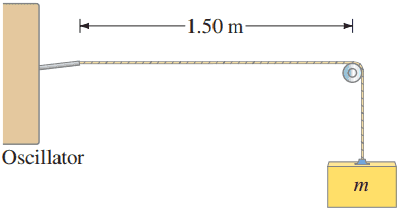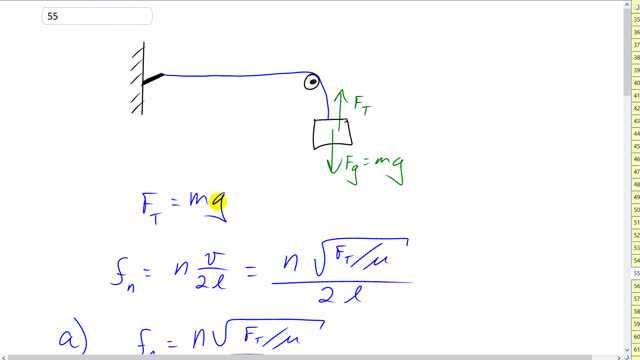
One end of a horizontal string is attached to a small-amplitude mechanical 60.0-Hz oscillator. The string’s mass per unit length is . The string passes over a pulley, a distance l = 1.50 m away, and weights are hung from this end, Fig. 11–55. What mass must be hung from this end of the string to produce
- one loop,
- two loops, and
- five loops of a standing wave? Assume the string at the oscillator is a node, which is nearly true.


In order to watch this solution you need to have a subscription.
This is Giancoli Answers with Mr. Dychko. The weight hanging off the string here is going to experience the force of gravity downwards and a tension force upwards. And since the weight is not moving, the tension up is going to be equal to the weight down. So, that gives us a tension in the string. We know what the length is between the oscillator and the pulley 1.5 meters. And this oscillator is going a very small amplitude oscillation up and down of 60 hertz. And knowing that it's a small amplitude is important because we're gonna be considering this a node. So, a node technically doesn't move at all, but if we say that it moves up and down just a little bit then we can still think of it as a node. And that means for part a where we have one loop we're gonna have a standing wave pattern like this where it oscillates between that and that. And so it has one antinode, two nodes a node on each end and then one antinode in the middle. So, we know that the nth frequency is going to be n times the wave speed on the string divided by 2 times its length. And the wave speed is the square root of the tension in the string divided by its mass per unit link and we're gonna solve this for m but first let's solve it for tension force and then knowing that tension force is mg, we'll substitute for that later. So, we can multiply both sides by 2 times length and we get that square root tension divided by mass per unit length is 2 l times the nth harmonic divided by n. And then square both sides, you get tension over μ is 4 l squared Fn squared over n squared. And then square both sides and this becomes... Maybe I didn't quite said that all perfectly but I think this should make sense anyway. So, we multiply both sides by 2 l here and the 2 l disappeared from the right hand side and... Oh, I'm dividing by n as well by the way. And so these disappear from that side and then we have Fn times 2 l over n. And then the square root business is on its own. And we switch the sides around. OK. Then square both sides and you get FT over μ is 4 l squared Fn squared over n squared. And then multiply both sides by μ. OK. And then substitute for tension, it's mg and then divide both sides by g to finally solve for m. So, the mass is 4 l squared times the frequency squared times mass per unit length divided by g times n squared. And so in the first case where you have just one loop you can think of n is actually being the number of antinodes in this case. So, the first mass is going to be 4 times 1.5 meters squared times 60 hertz squared times 3.5 times 10 to the minus 4 kilograms per meter divided by 9.8 newtons per kilogram times 1 squared because 1 is the number of antinodes. And that gives us 1.2 kilograms when you plug that into the calculator. And in every other case when we're finding the nth mass we're always going to be taking this m1 which is what we found here and dividing it by h squared because in every case the frequency will be 60 hertz because that's the frequency of the oscillator. And so it derives this string to have that frequency of 60 hertz. So, it has to be 60. And so as we solve for m2 and m5 we're gonna be plugging the exact same numbers in here for everything, same frequency, same mass per unit length, same length of the string and divided by g and so on. And the only thing that'll be different is this n, the number of antinodes. So, and then we want to have two antinodes. Is that the next 1? Yeah, m2. And so we're going to take this m1 divided by 2 squared which gives 0.29. And then m1 divided by 5 squared is 4.6 times 10 to the minus 2 kilograms.